Excerpts from Jim Conrad's
Naturalist Newsletter
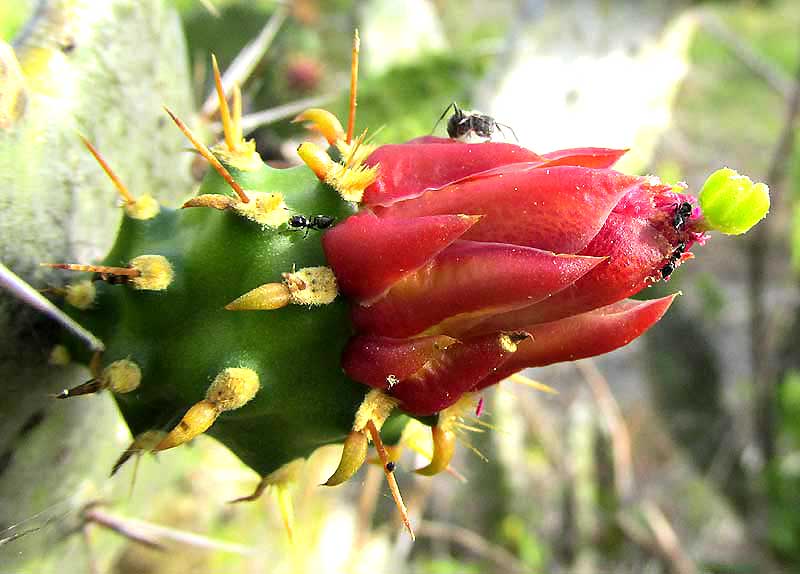
from the March 15, 2015 Newsletter issued from Río Lagartos, on the Yucatan Peninsula's northern coast (~N21.60°, ~W88.16°), Yucatán state, MÉXICO
FLOWER OF WILD NOPAL CACTUS
When the following profile was produced, no well formed flower was available. Now in March I've finally found a good one, shown above.
from the January 4, 2015 Newsletter issued from Río Lagartos, on the Yucatan Peninsula's northern coast (~N21.60°, ~W88.16°), Yucatán state, MÉXICO
WILD NOPAL CACTUS
Several cactus species endemic to only the northern Yucatan Peninsula occur in this area. Therefore, I'm watching closely for flowering individuals, since often flowers and/or fruits are needed for solid identifications. This week a large, tree-type, commonly occurring one turned up producing small, red blossoms. It's a species often growing inside dense scrub, entangling its flat, succulent branches with woody stems of small trees -- which now in the dry season often are leafless -- as shown below:
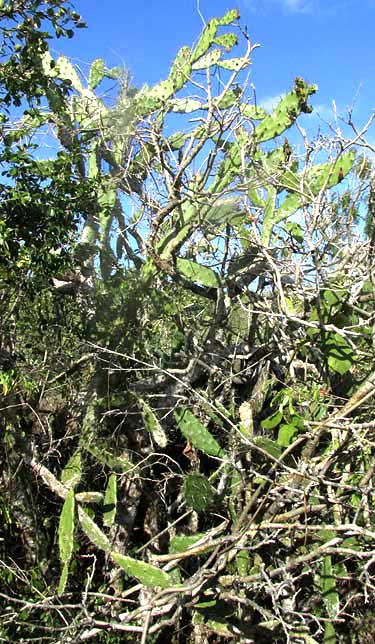
This big cactus's only open flower is shown below:
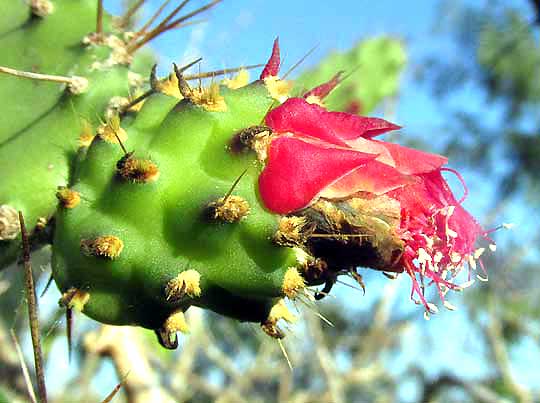
This blossom looks damaged on its bottom side, but still you can see that its stamens project beyond the corolla, and that the spine clusters, or "areoles," on the developing ovary, or future fruit, are woolly with short, tan hairs, plus slender, sharp spines emerge from most of them. I visited this cactus every other day for a week hoping to photograph an undamaged blossom but no new flowers appeared.
Another shot showing a developing ovary with its deep cavity left by the shed corolla is shown below:
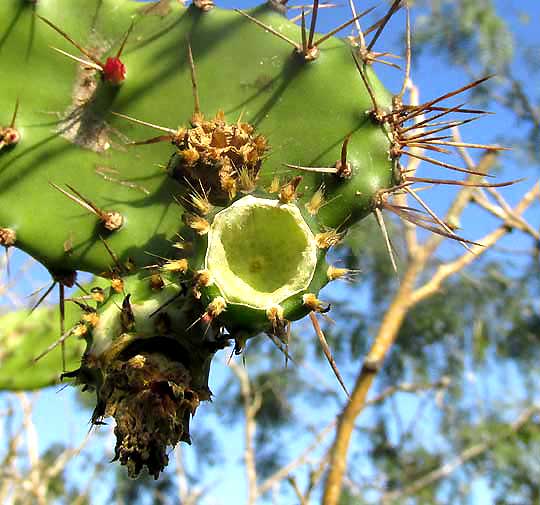
Most cactus species with flattened pads like this one produce flowers mainly along its pads' margins, but this species habitually develops blossoms on the pads' flat faces. Below you can see flower buds developing:
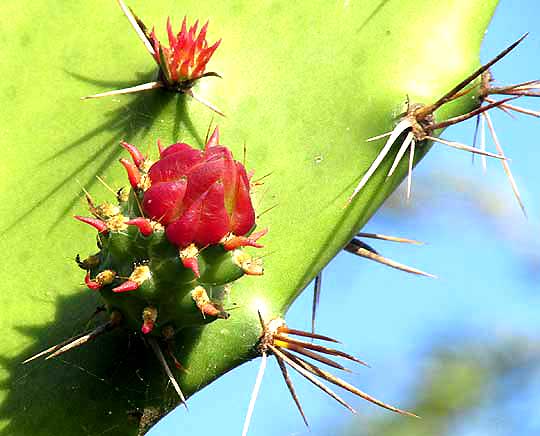
Spines on mature pads start out as grayish but turn dark, as shown below:
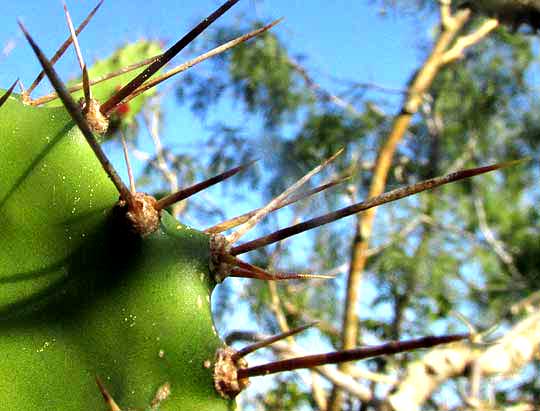
The cylindrical trunk is about six inches thick (15cm), shown below:
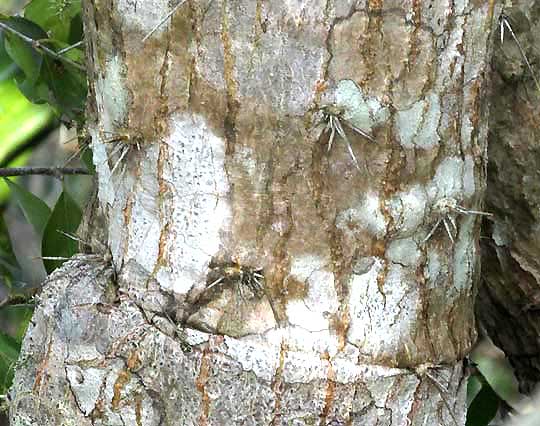
Cactus classification has always been in a mess, maybe because most taxonomists don't want to deal with spiny pods that are hard to dry and mount on sheets the way botanical specimens normally are. This species' status is especially hard to get a fix on because it's found only in the northern Yucatan Peninsula and isn't well studied.
However, using the list of cactuses known to occur in Ría Largartos Biosphere Reserve, and viewing preserved plant specimens collected in the northern Yucatan and displayed online by Arizona State University, I can say that our scrub-growing cactus almost certainly is NOPALEA INAPERTA. Some experts lump the genus Nopalea with the genus Opuntia, making it Opuntia inaperta and thus one of many species of prickly pear. Nopalea species are known as nopal cactuses and are much esteemed in Mexico for their edible young pads. Sometimes this one is referred to as Wild Nopal Cactus.
One issue with this species' name is that certain specialists recognize another very similar cactus sharing the same limited distribution with Nopalea inaperta, and that's Nopalea gaumeri. However, other specialists simply lump the two species, saying that Nopalea gaumeri is a mere variation of Nopalea inaperta. The Arizona State University site shows specimens designated as both species. You can review their Nopalea inaperta page at http://swbiodiversity.org/seinet/taxa/index.php?taxon=Nopalea%20inaperta.
Their Nopalea gaumeri page is at http://swbiodiversity.org/seinet/taxa/index.php?taxon=Nopalea%20gaumeri
The only difference I see between them is that Nopalea gaumeri is smaller, not growing much over 2m (7ft), while Nopalea inaperta exceeds twice that high. The one in our picture was about 4.5m tall (15ft).
Yet a third Nopalea species occurs in our area, the much more widely distributed and fairly famous Cochineal Nopal Cactus, which grew near our hut at Chichén Itzá ruins, and which you can compare with our present Nopalea at www.backyardnature.net/yucatan/nopalea.htm.
The only difference I see between the Cochineal Nopal and our scrub-growing one is that the Cochineal one is much less spiny. It's thought that ancient indigenous people selectively planted Cochineal cacti, striving for ever-less spiny pads, so that both eating the pads and growing cochineal larvae on them would be easier. The thought occurs that maybe our Nopalea inaperta might be the Cochineal Nopal's spiny ancestor. One can even visualize Nopalea gaumeri as possibly an ancient attempt to create a smaller, more manageable nopal. But, who knows? It's a fascinating cluster of species.
Meanwhile, I'm doing a lot of crashing through the local scrub looking for little Nopalea gaumeri.
from the March 15, 2015 Newsletter issued from Río Lagartos, on the Yucatan Peninsula's northern coast (~N21.60°, ~W88.16°), Yucatán state, MÉXICO
GAUMER'S NOPAL CACTUS
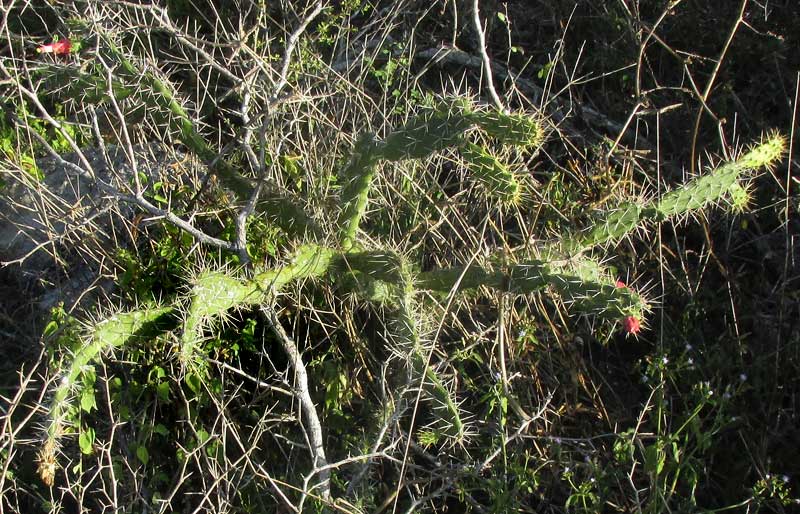
In this year's January 4th Newsletter we looked at a 4.5m tall (15ft), prickly-pear-type cactus, the Scrub Cactus, Nopalea inaperta, common in this area {above entries}. There I mention that another very similar cactus shares the same limited distribution with the Scrub Cactus, and that's Gaumer's Nopal Cactus, Nopalea gaumeri*.
Now I've found some, and they were flowering. The plants were much smaller than Scrub Cactus, only about knee high, as shown above. As with the earlier Scrub Cactuses, these plants grew amid thick brush in thin soil atop limestone. In fact, numerous Scrub Cactus plants inhabited the same area. A 2m tall one (7ft) stood only 3m away (10ft) from the small one in the picture. Several of these smaller cacti were in the area, but also there were cacti of intermediate size. The smaller cactus's joints were less flattened than those of the bigger ones, but there were transition states between cylindrical and flattened, too. So, just focusing on cactus size and joint shape, it was hard to say whether two species were being dealt with, or just one.
However, one big difference between the tall and short plants was that all the smaller ones were flowering, while the larger Scrub Cacti mostly were not. A branch showing some of the short cactus's spiny pads and flowers is shown below:
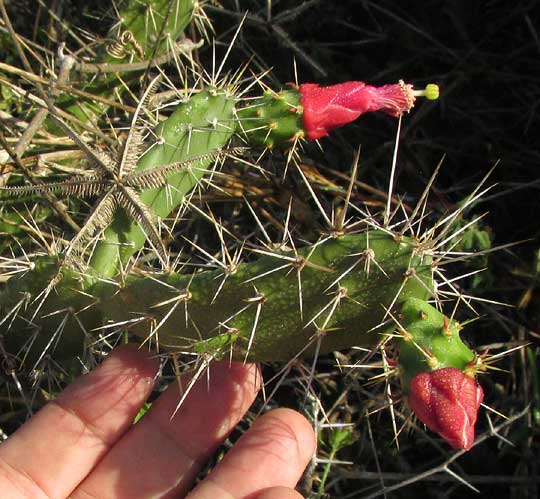
A close-up of a flower showing the yellow-green, deeply lobed stigma on its white style protruding beyond a dense cluster of stamens with yellow anthers and pink filaments is shown below:
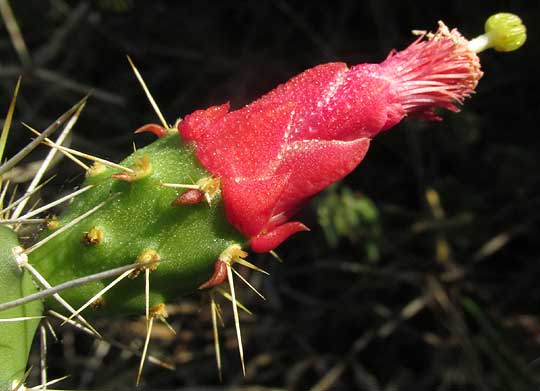
Another feature the above picture shows is that the green ovary below the red sepals and corolla bears clusters of well formed spines. The larger Scrub Cactus's ovaries also bear spine clusters, but the spines are shorter and more slender than these.
A look at spine clusters on the small cactus's pad is seen below:
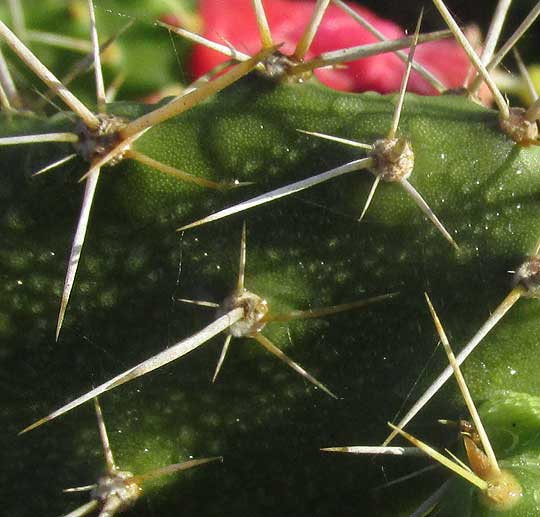
So, do I think that these small cacti constitute the distinct species known as Nopalea gaueri, or are they just a local variation of the common Scrub Cactus, Nopalea inaperta?
On the basis of the smaller cactuses all flowering at the same time while surrounding Nopalea inaperta plants were only rarely flowering, and because of the much larger spines on the smaller cactus's ovaries, I'm thinking that probably two species are involved, and that the smaller ones are NOPALEA GAUMERI. This species really has no English name, but we'll call it Gaumer's Nopal Cactus.
Gaumer's Nopal Cactus is endemic to only the northern third or so of the Yucatan Peninsula, and mostly in the more arid northwest.